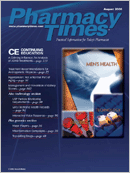Publication
Article
Pharmacy Times
This Error Happens More Often Than
Author(s):
The Problem
Misinterpretation of abbreviations is a common source of error. The abbreviation "QD," used to indicate once daily, is frequently misread. Two reports recently sent to the Institute for Safe Medication Practices (ISMP) illustrate (Figures 1 and 2) how easily "QD" can be construed as "QID" (4 times daily), resulting in patients receiving 4 times the intended daily dose. Fortunately, in each of these cases, errors were recognized before any patient harm occurred.
A newspaper article, however, described a similar error that put a patient (as well as others) at risk for significant harm.1 The article explained that a prescription was written for a 1-month supply of AVINZA (morphine sulfate extended-release) 30 mg QD for a man with severe back pain. The pharmacist misinterpreted the "QD" and dispensed the prescription with the instructions "Take one capsule 4 times daily." Although the product package insert states that AVINZA should not be administered more frequently than every 24 hours, the pharmacist may not have been familiar with this warning, because it was a new medication at the time. In addition, there were no computer warnings to alert that the frequency of administration was inappropriate for the medication.
The patient followed the instructions on the prescription label and experienced excessive drowsiness and sedation but continued to work (as a construction inspector) and to drive (often with his 7-year-old daughter in the car). The error was discovered when the patient, who was almost out of medication, contacted his doctor for a refill after only 1 week.
The Solution
Given the potential for confusion and risk for patient harm, health care practitioners should stop using the abbreviation "QD" in all forms of communication. This prohibition should include written, telephoned, verbal, or transcribed prescriptions, internal communications, medication administration records, computer order entry screens, and computergenerated labels.
Instead, the word "daily" should be used in these communications. With only 3 more letters than the abbreviation it replaces, it offers a much safer alternative. Staff members should be educated regarding the potential for error with the common abbreviation "QD." Pharmacists should keep this problem in mind and clarify prescriptions for which "QID" dosing may be out of the ordinary. Consider adding computer alerts to drugs that are dosed once daily, so that a reminder will appear if a dosing frequency other than "daily" is entered.
Prescribers and staff members should make sure that patients are aware of how often they are to take the medication. Pharmacists should verify the dosing frequency with patients by asking an open-ended question, such as "How often are you supposed to take this medication?" rather than instructing, "You are to take one capsule 4 times daily."
In June 2006, the FDA and ISMP launched a national education campaign to help eliminate the use of error-prone abbreviations. The campaign is focusing on eliminating the use of misleading abbreviations by health care professionals and students, medical communications and publishing professionals, the pharmaceutical industry, and FDA staff. As part of the campaign, ISMP and the FDA have developed a tool kit of resource materials. The tool kit?as well as ISMP's List of Error-Prone Abbreviations, Symbols, and Dose Designations?is available from the ISMP Web site at www.ismp.org/Tools/abbreviations/default.asp.
Dr. Gaunt is a medication safety analyst and the editor of ISMP Medication Safety Alert! Community/Ambulatory Care Edition.
For a list of references, send a stamped, self-addressed envelope to: References Department, Attn. A. Rybovic, Pharmacy Times, Ascend Media Healthcare, 103 College Road East, Princeton, NJ 08540; or send an email request to: [email protected]

Newsletter
Stay informed on drug updates, treatment guidelines, and pharmacy practice trends—subscribe to Pharmacy Times for weekly clinical insights.






